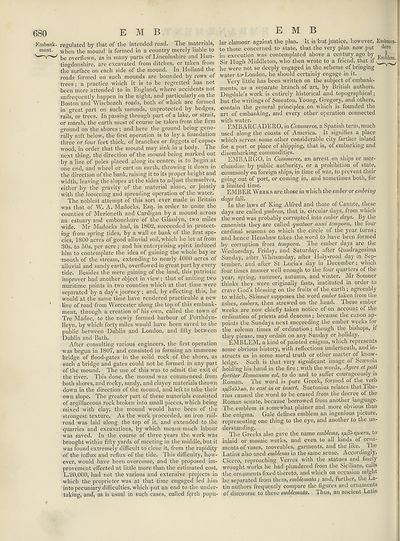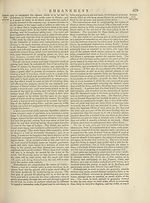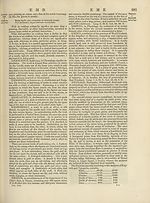Encyclopaedia Britannica > Volume 8, DIA-England
(690) Page 680
Download files
Complete book:
Individual page:
Thumbnail gallery: Grid view | List view

680 E M B
Embank- regulated by that of the intended road. The materials,
ment- when the mound is formed in a country merely liable to
be overflown, as in many parts of Lincolnshire and Hun¬
tingdonshire, are excavated from ditches, or taken from
the surface on each side of the mound. In Holland the
roads formed on such mounds are bounded by rows of
trees ; a practice which it is to be regretted has not
been more attended to in England, where accidents not
unfrequently happen in the night, and particularly on the
Boston and Wisebeach roads, both of which are formed
in great part on such mounds, unprotected by hedges,
rails, or trees. In passing through part of a lake, or strait,
or marsh, the earth must of course be taken from the firm
ground on the shores ; and here the ground being gene¬
rally soft below, the first operation is to lay a foundation
three or four feet thick, of branches or faggots of copse-
wood, in order that the mound may sink in a body. I he
next thing, the direction of the mound being marked out
by a line of poles placed along its centre, is to begin at
one end, and wheel or cart on earth, throwing it down in
the direction of the bank, raising it to its proper height and
width, leaving the slopes at the sides to adjust themselves,
either by the gravity of the material alone, or jointly
with the loosening and spreading operation of the water.
The noblest attempt of this sort ever made in Britain
was that of W. A. Madocks, Esq. in order to unite the
counties of Merioneth and Cardigan by a mound across
an estuary and embouchure of the Glasslyn, two miles
wide. Mr Madocks had, in 1802, succeeded in protect¬
ing fiom spring tides, by a wall or bank of the first spe¬
cies, 1800 acres of good alluvial soil, which he let at from
30s. to 50s. per acre; and his enterprising spirit induced
him to contemplate the idea of gaining the whole bay or
mouth of the stream, extending to nearly 4000 acres of
alluvial and sandy earth, overflowed in great part by every
tide. Besides the mere gaining of the land, this patriotic
improver had another object in view ; that of uniting two
maritime points in two counties which at that time were
separated by a day’s journey; and, by effecting this, he
would at the same time have rendered practicable a new
‘ line of road from Worcester along the top of this embank¬
ment, through a creation of his own, called the town of
Tre Madoc, to the newly formed harbour of Porthdyn-
lleyn, by which forty miles would have been saved to the
public between Dublin and London, and fifty between
Dublin and Bath.
After consulting various engineers, the first operation
was begun in 1807, and consisted in forming an immense
bridge of flood-gates in the solid rock of the shore, as
such a bridge and gates could not be formed in any part
of the mound. The use of this was to admit the exit of
the river. This done, the mound was commenced from
both shores, and rocky, sandy, and clayey materials thrown
down in the direction of the mound, and left to take their
own slope. The greater part of these materials consisted
of argillaceous rock broken into small pieces, which being
mixed with clay, the mound would have been of the
strongest texture. As the work proceeded, an iron rail¬
road was laid along the top of it, and extended to the
quarries and excavations, by which means much labour
was saved. In the course of three years the work was
brought within fifty yards of meeting in the middle, but it
was found extremely difficult to close it, from the rapidity
of the influx and reflux of the tide. This difficulty, how¬
ever, would have been overcome, and the proposed im¬
provement effected at little more than the estimated cost,
L.20,000, had not the various and extensive projects in
which the proprietor was at that time engaged led him
into pecuniary difficulties, which put an end to the under¬
taking, and, as is usual in such cases, called forth popu-
E M B
lar clamour against the plan. It is but justice, however, Embarca-
to those concerned to state, that the very plan now put dero
in execution was contemplated above a century ago by Emj!.
Sir Hugh Middleton, who then wrote to a friend, that if
he were not so deeply engaged in the scheme of bringing
water to*London, he should certainly engage in it.
Very little has been written on the subject of embank¬
ments, as a separate branch of art, by British authors.
Dugdale’s work is entirely historical and topographical;
but the writings of Smeaton, Young, Gregory, and others,
contain the general principles on which is founded the
art of embanking, and every other operation connected
with water.
EMBARCADERO, in Commerce, a Spanish term, much
used along the coasts of America. It signifies a place
which serves some other considerable city farther inland
for a port or place of shipping, that is, of embarking and
disembarking commodities.
EMBARGO, in Commerce, an arrest on ships or mer¬
chandise by public authority, or a prohibition of state,
commonly on foreign ships, in time of war, to prevent their
going out of port, or coming in, and sometimes both, for
a limited time.
EMBER Weeks are those in which the ember or embring
days fall.
In the laws of King Alfred and those of Canute, these
days are called ymbren, that is, circular days, from which
the word was probably corrupted into ember days. By the
canonists they are called quatuor anni tempora, the four
cardinal seasons on which the circle of the year turns;
and hence Henshaw takes the word to have been formed
by corruption from tempora. The ember days are the
Wednesday, Friday, and Saturday, after Quadragesima
Sunday, after Whitsunday, after Holy-rood day in Sep¬
tember, and after St Lucia’s day in December; which
four times answer well enough to the four quarters of the
year, spring, summer, autumn, and winter. Mr Somner
thinks they were originally fasts, instituted in order to
crave God’s blessing on the fruits of the earth; agreeably
to which, Skinner supposes the word ember taken from the
ashes, embers, then strewed on the head. These ember
weeks are now chiefly taken notice of on account of the
ordination of priests and deacons; because the canon ap¬
points the Sundays next succeeding the ember weeks for
the solemn times of ordination; though the bishops, if
they please, may ordain on any Sunday or holiday.
EMBLEM, a kind of painted enigma, which represents
some obvious history, with reflections underneath, and in¬
structs us in some moral truth or other matter of know¬
ledge. Such is that very significant image of Scmvola
holding his hand in the fire ; with the words, Agere et pati
fortiter Romanum est, to do and to suffer courageously is
Roman. The word is pure Greek, formed of the verb
to cast in or insert. Suetonius relates that l ibe-
rius caused the word to be erased from the deciee of the
Roman senate, because borrowed from another language.
The emblem is somewhat plainer and more obvious than
the enigma. Gale defines emblem an ingenious picture,
representing one thing to the eye, and another to the un¬
derstanding.
The Greeks also gave the name emblems, t/t/S^/xara, to
inlaid or mosaic works, and even to all kinds of orna¬
ments of vases, moveables, garments, and the like. . dhe
Latins also used emblema in the same sense. Accordingly,
Cicero, reproaching Verres with the statues and finely
wrought works he had plundered from the Sicilians, calls
the ornaments fixed thereto, and which on occasion might
be separated from them, emblemata ; and, further, the La¬
tin authors frequently compare the figures and ornaments
of discourse to these emblemata. Ihus, an ancient Latin
Embank- regulated by that of the intended road. The materials,
ment- when the mound is formed in a country merely liable to
be overflown, as in many parts of Lincolnshire and Hun¬
tingdonshire, are excavated from ditches, or taken from
the surface on each side of the mound. In Holland the
roads formed on such mounds are bounded by rows of
trees ; a practice which it is to be regretted has not
been more attended to in England, where accidents not
unfrequently happen in the night, and particularly on the
Boston and Wisebeach roads, both of which are formed
in great part on such mounds, unprotected by hedges,
rails, or trees. In passing through part of a lake, or strait,
or marsh, the earth must of course be taken from the firm
ground on the shores ; and here the ground being gene¬
rally soft below, the first operation is to lay a foundation
three or four feet thick, of branches or faggots of copse-
wood, in order that the mound may sink in a body. I he
next thing, the direction of the mound being marked out
by a line of poles placed along its centre, is to begin at
one end, and wheel or cart on earth, throwing it down in
the direction of the bank, raising it to its proper height and
width, leaving the slopes at the sides to adjust themselves,
either by the gravity of the material alone, or jointly
with the loosening and spreading operation of the water.
The noblest attempt of this sort ever made in Britain
was that of W. A. Madocks, Esq. in order to unite the
counties of Merioneth and Cardigan by a mound across
an estuary and embouchure of the Glasslyn, two miles
wide. Mr Madocks had, in 1802, succeeded in protect¬
ing fiom spring tides, by a wall or bank of the first spe¬
cies, 1800 acres of good alluvial soil, which he let at from
30s. to 50s. per acre; and his enterprising spirit induced
him to contemplate the idea of gaining the whole bay or
mouth of the stream, extending to nearly 4000 acres of
alluvial and sandy earth, overflowed in great part by every
tide. Besides the mere gaining of the land, this patriotic
improver had another object in view ; that of uniting two
maritime points in two counties which at that time were
separated by a day’s journey; and, by effecting this, he
would at the same time have rendered practicable a new
‘ line of road from Worcester along the top of this embank¬
ment, through a creation of his own, called the town of
Tre Madoc, to the newly formed harbour of Porthdyn-
lleyn, by which forty miles would have been saved to the
public between Dublin and London, and fifty between
Dublin and Bath.
After consulting various engineers, the first operation
was begun in 1807, and consisted in forming an immense
bridge of flood-gates in the solid rock of the shore, as
such a bridge and gates could not be formed in any part
of the mound. The use of this was to admit the exit of
the river. This done, the mound was commenced from
both shores, and rocky, sandy, and clayey materials thrown
down in the direction of the mound, and left to take their
own slope. The greater part of these materials consisted
of argillaceous rock broken into small pieces, which being
mixed with clay, the mound would have been of the
strongest texture. As the work proceeded, an iron rail¬
road was laid along the top of it, and extended to the
quarries and excavations, by which means much labour
was saved. In the course of three years the work was
brought within fifty yards of meeting in the middle, but it
was found extremely difficult to close it, from the rapidity
of the influx and reflux of the tide. This difficulty, how¬
ever, would have been overcome, and the proposed im¬
provement effected at little more than the estimated cost,
L.20,000, had not the various and extensive projects in
which the proprietor was at that time engaged led him
into pecuniary difficulties, which put an end to the under¬
taking, and, as is usual in such cases, called forth popu-
E M B
lar clamour against the plan. It is but justice, however, Embarca-
to those concerned to state, that the very plan now put dero
in execution was contemplated above a century ago by Emj!.
Sir Hugh Middleton, who then wrote to a friend, that if
he were not so deeply engaged in the scheme of bringing
water to*London, he should certainly engage in it.
Very little has been written on the subject of embank¬
ments, as a separate branch of art, by British authors.
Dugdale’s work is entirely historical and topographical;
but the writings of Smeaton, Young, Gregory, and others,
contain the general principles on which is founded the
art of embanking, and every other operation connected
with water.
EMBARCADERO, in Commerce, a Spanish term, much
used along the coasts of America. It signifies a place
which serves some other considerable city farther inland
for a port or place of shipping, that is, of embarking and
disembarking commodities.
EMBARGO, in Commerce, an arrest on ships or mer¬
chandise by public authority, or a prohibition of state,
commonly on foreign ships, in time of war, to prevent their
going out of port, or coming in, and sometimes both, for
a limited time.
EMBER Weeks are those in which the ember or embring
days fall.
In the laws of King Alfred and those of Canute, these
days are called ymbren, that is, circular days, from which
the word was probably corrupted into ember days. By the
canonists they are called quatuor anni tempora, the four
cardinal seasons on which the circle of the year turns;
and hence Henshaw takes the word to have been formed
by corruption from tempora. The ember days are the
Wednesday, Friday, and Saturday, after Quadragesima
Sunday, after Whitsunday, after Holy-rood day in Sep¬
tember, and after St Lucia’s day in December; which
four times answer well enough to the four quarters of the
year, spring, summer, autumn, and winter. Mr Somner
thinks they were originally fasts, instituted in order to
crave God’s blessing on the fruits of the earth; agreeably
to which, Skinner supposes the word ember taken from the
ashes, embers, then strewed on the head. These ember
weeks are now chiefly taken notice of on account of the
ordination of priests and deacons; because the canon ap¬
points the Sundays next succeeding the ember weeks for
the solemn times of ordination; though the bishops, if
they please, may ordain on any Sunday or holiday.
EMBLEM, a kind of painted enigma, which represents
some obvious history, with reflections underneath, and in¬
structs us in some moral truth or other matter of know¬
ledge. Such is that very significant image of Scmvola
holding his hand in the fire ; with the words, Agere et pati
fortiter Romanum est, to do and to suffer courageously is
Roman. The word is pure Greek, formed of the verb
to cast in or insert. Suetonius relates that l ibe-
rius caused the word to be erased from the deciee of the
Roman senate, because borrowed from another language.
The emblem is somewhat plainer and more obvious than
the enigma. Gale defines emblem an ingenious picture,
representing one thing to the eye, and another to the un¬
derstanding.
The Greeks also gave the name emblems, t/t/S^/xara, to
inlaid or mosaic works, and even to all kinds of orna¬
ments of vases, moveables, garments, and the like. . dhe
Latins also used emblema in the same sense. Accordingly,
Cicero, reproaching Verres with the statues and finely
wrought works he had plundered from the Sicilians, calls
the ornaments fixed thereto, and which on occasion might
be separated from them, emblemata ; and, further, the La¬
tin authors frequently compare the figures and ornaments
of discourse to these emblemata. Ihus, an ancient Latin
Set display mode to:
![]() Universal Viewer |
Universal Viewer | ![]() Mirador |
Large image | Transcription
Mirador |
Large image | Transcription
Images and transcriptions on this page, including medium image downloads, may be used under the Creative Commons Attribution 4.0 International Licence unless otherwise stated. ![]()
| Encyclopaedia Britannica > Encyclopaedia Britannica > Volume 8, DIA-England > (690) Page 680 |
|---|
| Permanent URL | https://digital.nls.uk/193331975 |
|---|
| Attribution and copyright: |
|
|---|
| Description | Ten editions of 'Encyclopaedia Britannica', issued from 1768-1903, in 231 volumes. Originally issued in 100 weekly parts (3 volumes) between 1768 and 1771 by publishers: Colin Macfarquhar and Andrew Bell (Edinburgh); editor: William Smellie: engraver: Andrew Bell. Expanded editions in the 19th century featured more volumes and contributions from leading experts in their fields. Managed and published in Edinburgh up to the 9th edition (25 volumes, from 1875-1889); the 10th edition (1902-1903) re-issued the 9th edition, with 11 supplementary volumes. |
|---|---|
| Additional NLS resources: |
|

